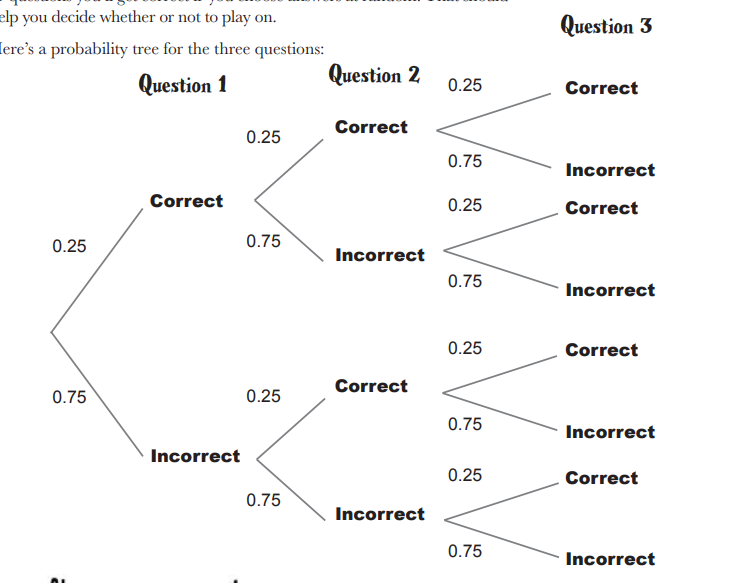This is an old revision of the document!
Binomial Distributions
- 1번의 시행에서 특정 사건 A가 발생할 확률을 p라고 하면
- n번의 (독립적인) 시행에서 사건 A가 발생할 때의 확률 분포를
- 이항확률분포라고 한다.
아래를 보면
- 각 한문제를 맞힐 확률은 1/4, 틀릴 확률은 3/4
- 3문제를 풀면서 (3번의 시행) 각 문제를 맞힐 확률 분포를 말한다.
| x | P(X=x) | power of .75 | power of .25 |
| 0 | 0.75 * 0.75 * 0.75 | 3 | 0 |
| 1 | 3 * (0.75 * 0.75 * 0.25) | 2 | 1 |
| 2 | 3 * (0.75 * 0.25 * 0.25) | 1 | 2 |
| 3 | 0.25 * 0.25 * 0.25 | 0 | 3 |
$$P(X = r) = {\huge\text{?} \cdot 0.25^{r} \cdot 0.75^{3-r}} $$
$$P(X = r) = {\huge_{3}C_{r}} \cdot 0.25^{r} \cdot 0.75^{3-r}$$
$_{n}C_{r}$은 n개의 사물에서 r개를 (순서없이) 고르는 방법의 수라고 할 때, 3개의 질문 중에서 한 개의 정답을 맞히는 방법은 $_{3}C_{1} = 3$ 세가지가 존재.
Probability for getting one question right
\begin{eqnarray*}
P(X = r) & = & _{3}C_{1} \cdot 0.25^{1} \cdot 0.75^{3-1} \\
& = & \frac{3!}{1! \cdot (3-1)!} \cdot 0.25 \cdot 0.75^2 \\
& = & 3 \cdot 0.25 \cdot 0.5625 \\
& = & 3 \cdot 0.25 \cdot 0.5625 \\
& = & 0.421875
\end{eqnarray*}
$$P(X = r) = _{n}C_{r} \cdot 0.25^{r} \cdot 0.75^{n-r}$$
$$P(X = r) = _{n}C_{r} \cdot p^{r} \cdot q^{n-r}$$
- You’re running a series of independent trials. (n번의 시행을 하게 된다)
- There can be either a success or failure for each trial, and the probability of success is the same for each trial. (각 시행은 성공/실패로 구분되고 성공의 확률은 (반대로 실패의 확률도) 각 시행마다 동일하다)
- There are a finite number of trials. Note that this is different from that of geometric distribution. (n번의 시행으로 한정된다. 무한대 시행이 아님)
X가 n번의 시행에서 성공적인 결과를 얻는 수를 나타낸다고 할 때, r번의 성공이 있을 확률을 구하려면 아래 공식을 이용한다.
\begin{eqnarray*} P(X = r) & = & _{n}C_{r} \cdot p^{r} \cdot q^{n-r} \;\;\; \text{Where,} \\ _{n}C_{r} & = & \frac {n!}{r!(n-r)!} \end{eqnarray*}
p = 각 시행에서 성공할 확률
n = 시행 숫자
r = r 개의 정답을 구할 확률
$$X \sim B(n,p)$$
Expectation and Variance of
Toss a fair coin once. What is the distribution of the number of heads?
- A single trial
- The trial can be one of two possible outcomes – success and failure
- P(success) = p
- P(failure) = 1-p
X = 0, 1 (failure and success)
$P(X=x) = p^{x}(1-p)^{1-x}$ or
$P(x) = p^{x}(1-p)^{1-x}$
참고.
| x | 0 | 1 |
| p(x) | q = (1-p) | p |
When x = 0 (failure), $P(X = 0) = p^{0}(1-p)^{1-0} = (1-p)$ = Probability of failure
When x = 1 (success), $P(X = 1) = p^{1}(1-p)^{0} = p $ = Probability of success
This is called Bernoulli distribution.
- Bernoulli distribution expands to binomial distribution, geometric distribution, etc.
- Binomial distribution = The distribution of number of success in n independent Bernoulli trials.
- Geometric distribution = The distribution of number of trials to get the first success in independent Bernoulli trials.
$$X \sim B(1,p)$$
\begin{eqnarray*} E(X) & = & \sum{x * p(x)} \\ & = & (0*q) + (1*p) \\ & = & p \end{eqnarray*}
\begin{eqnarray*} Var(X) & = & E((X - E(X))^{2}) \\ & = & \sum_{x}(x-E(X))^2p(x) \ldots \ldots \ldots E(X) = p \\ & = & (0 - p)^{2}*q + (1 - p)^{2}*p \\ & = & (0^2 - 2p0 + p^2)*q + (1-2p+p^2)*p \\ & = & p^2*(1-p) + (1-2p+p^2)*p \\ & = & p^2 - p^3 + p - 2p^2 + p^3 \\ & = & p - p^2 \\ & = & p(1-p) \\ & = & pq \end{eqnarray*}
For generalization,
$$X \sim B(n,p)$$
\begin{eqnarray*} E(X) & = & E(X_{1}) + E(X_{2}) + ... + E(X_{n}) \\ & = & n * E(X_{i}) \\ & = & n * p \end{eqnarray*}
\begin{eqnarray*} Var(X) & = & Var(X_{1}) + Var(X_{2}) + ... + Var(X_{n}) \\ & = & n * Var(X_{i}) \\ & = & n * p * q \end{eqnarray*}



